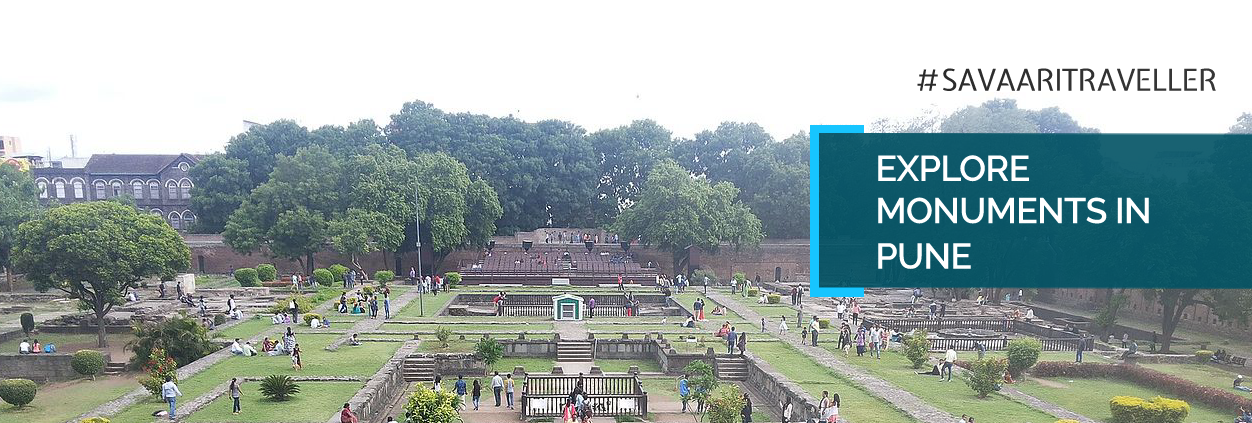10 places of historical interest in Pune
From the ‘Oxford of the east’ to becoming the ‘Rock Capital’ of the country, the cultural hub of Maharashtra has undergone quite a roller coaster ride of history and evolution. Even though the flourishing technology and education industry has swept aside the golden days of this historical town, Pune still has some traces of its luxurious past in its heritage buildings and monuments. Ruled and inhabited by the Mughals, Marathas, Peshwas, Iranis, Jews and finally the British, the city of Pune reflects their influence on every piece of its past.
Here’s a list of the best evidence of the city’s architectural and historical wonder.
Pune’s top 10 historical places
Take a drive down the old haunts of Pune and witness the remnants of its grandeur.
Shaniwar Wada
The ‘love palace’ of the great Peshwa Bajirao and his wife Kashibai, the Shaniwar Wada also served as the Peshwa administrative headquarters of its time. Built in 1730, the palace spreads across a whopping area of 652 acres, flanked by forts and mountains, moats and gardens. A major destination (more so after the movie) for tourists and history lovers, this old fort has also gained recognition as a haunted palace. Try visiting at night for some ‘first-hand encounter’ of the lovelorn trio.
Ohel David Synagogue
The Jews of Pune were probably one of the handful ones who migrated to India in the 17th century. The Ohel David Synagogue stands as a memorabilia of this culturally rich and strong community. Built with red stone, it also came to be locally known as Lal Deval and was an important place of worship for the Jews. David Sassoon, a prominent historical figure of his time was the patron who initiated the construction of this religious site, among other important buildings.
Dargah of Shaikh Salla
Not an active dargah anymore, this religious site is more like a point of architectural interest to art students and history enthusiasts. It was built in the early years of the Persian rule when the first Muslims moved into the city.
Aga Khan Palace
Aga Khan, the highly revered and recognized leader of the Bohri Muslim community, was a prominent name in the history of Pune. This palace was built in 1892 in his honor by Sultan Muhammed Shah Aga Khan III (his descendant). Besides its religious and historical significance, the palace itself is an architectural masterpiece. A fine blend of Islamic artistry and colonial sculptures, this monument is a treat for the eyes.
Shivneri Fort
We have all heard the mention of this fort somewhere in our history lessons, stories or movies. A 17th-century structure of solid black stone, this fortress assumed the look of a robust military unit. As the birthplace of Chhatrapati Shivaji, the monument remains an important landmark in the history of the Marathas. Later, this fort was used as a strategic point for the Maratha army. You can trek across the surrounding hills to reach this fort at the top.
Sinhagad Fort
About 25 Km south of Pune city, sits the small fortress of Sinhagad. The monument dates back to 2000 years when the Turkish rulers Muhammad Bin Tughlaq occupied this region. Eventually, in the Battle of Sinhagad in 1670, Shivaji took over Tughlaq and his fort. Though in ruins, the place still emanates a vibe of victory, loss, heroism, and betrayal.
Vishram Bagh Wada
Yet another place of the Peshwas, the Vikram Bagh Wada was a prominent monument of the 18th century. Built in the early 1800s, this worked as the luxurious residence of the Peshwa Bajirao II. Though in ruins today, the remnants of the palace still speak of its bygone grandeur. The architecture reflects the ancient Maratha architectural style with elegantly carved pillars, wooden ceilings, and fine motifs.
Purandar fort
Right outside the city of Pune, you will find the Purandar Fort, near Saswad. Standing at 1350 meter above the ground, this fortress served as the capital of the Maratha Empire. Shivaji held his throne and administration of this kingdom from this guarded enclave. Presently, the fort still aligns to its military past and holds the National Cadet Corps Academy.
Shinde Chhatri
One of the lesser-known monuments of Pune, the Shinde Chhatri is more of a memorial than a historical residence. It was built in the memory of Mahadji Shinde, an 18th-century military leader and commander-in-chief of the Peshwas who ruled the region for more than 20 years. With intricate detailing on the walls and the massive iron gate, the palace reflects its classic Anglo-Rajasthani style of construction.
Nana Wada
Built by Nana Phadnavis in 1780, this is yet another significant historical landmark of Pune. Nana Phadnavis was an equivalent of a CEO to the Peshwa of its time and had quite an influence. His palace speaks of his prominent place in the administration. Fine woodwork, arches, carved ceiling and daintily crafted pillars with floral motifs, this palace still resonates the pomp and grandeur it once had.

